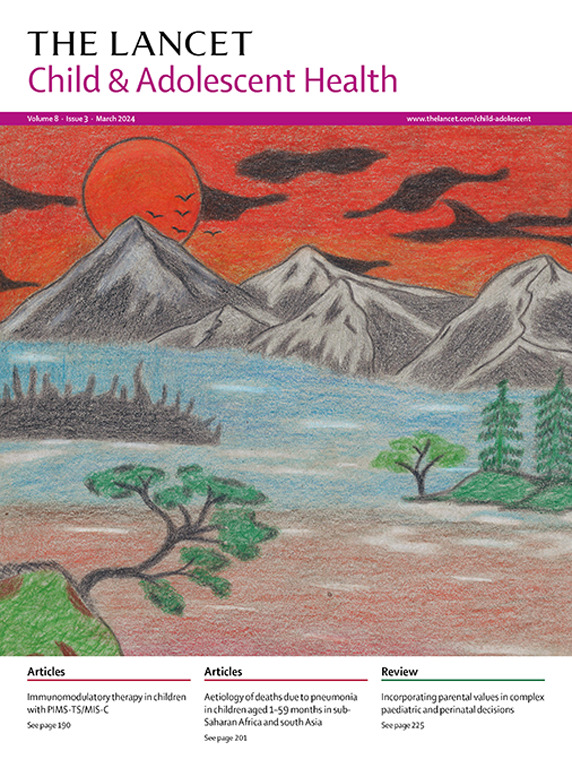胰岛素治疗无囊性纤维化相关性糖尿病(CF-IDEA)的囊性纤维化儿童早期血糖异常:一项随机对照试验
IF 15.5
1区 医学
Q1 PEDIATRICS
引用次数: 0
摘要
在口服葡萄糖耐量试验(OGTT)中,囊性纤维化患者在满足囊性纤维化相关糖尿病的诊断标准之前,可能已经有胰岛素分泌受损和高血糖。在几项小型、不受控制的试验中,对这类患者进行胰岛素治疗与改善体重和肺功能有关,但可能增加治疗负担并导致低血糖。我们的目的是评估胰岛素治疗是否能改善伴有早期血糖异常的囊性纤维化患者的体重和肺功能。scf - idea是一项多中心、随机对照试验,在澳大利亚的5家儿童医院和美国的1家儿童医院进行。符合条件的参与者为5-18岁囊性纤维化儿童,无囊性纤维化相关糖尿病,5点OGTT峰值葡萄糖浓度为8.2 - 11.0 mmol/L(囊性纤维化胰岛素缺乏1期)或≥11.1 mmol/L(囊性纤维化胰岛素缺乏2期)。参与者被随机(1:1)分配到胰岛素组或观察组。随机化是用有偏硬币法进行的,当研究组偶然变得不平衡时,将其最小化。随机分组根据血糖类别(囊性纤维化胰岛素缺乏1期或2期)、体重Z评分(大于等于- 0.61或小于- 0.61)和研究中心进行分层。胰岛素组患者在早餐前皮下注射长效胰岛素,每日一次,起始剂量为0.1单位/ kg /天,以0.5单位的增量进行调整,使所有指尖血糖浓度在4mmol /L至8mmol /L之间。主要结局是体重Z评分的绝对变化,1 s内预测用力呼气量百分比(ppFEV1)和预测用力肺活量百分比(ppFVC),由广义估计方程导出,并呈现双侧95% ci。记录严重低血糖事件(定义为需要外界帮助或导致意识水平下降或癫痫发作)、胰岛素相关不良事件以及血糖低于3.9 mmol/L时连续血糖监测(CGM)百分比时间作为安全结局。本研究已在ClinicalTrials.gov注册,编号NCT01100892,并已完成。在2010年12月6日至2022年2月25日期间,109名参与者被随机分配到观察组(n=54)或胰岛素组(n=55)。5名参与者在基线访问后退出,因此分析包括104名参与者(53名观察组和51名胰岛素组);95名参与者完成了12个月的治疗方案,9名仅完成了6个月。两组间基线特征相似;然而,观察组有30名(57%)男孩和23名(43%)女孩,而胰岛素组有23名(45%)男孩和28名(55%)女孩。12个月时每日胰岛素剂量中位数为0.12单位/ kg /天(范围0.05 - 0.41)。观察组与胰岛素组体重Z评分变化差异无统计学意义(差异胰岛素减去观察值0.07 [95% CI - 0.04 ~ 0.18];p=0·20),ppFEV1变化(1·2[-2·2 ~ 4·7];p= 0.48),或ppFVC变化(0.6[-2·6 ~ 3.8];p = 0·72)。同样,在囊性纤维化胰岛素缺乏1期和2期的亚组分析中也没有显著差异。未发生严重低血糖或胰岛素相关不良事件,且观察组与胰岛素组在CGM百分比时间小于3.9 mmol/L方面无差异。对于患有囊性纤维化和早期血糖异常的儿童和青少年,胰岛素治疗不能改善体重或肺功能。不符合OGTT标准的囊性纤维化相关糖尿病患者不应给予胰岛素治疗。澳大利亚国家卫生和医学研究委员会,澳大利亚囊性纤维化研究信托基金,辉瑞澳大利亚儿科内分泌护理研究基金,诺和诺德地区糖尿病支持计划,悉尼儿童医院基金会。本文章由计算机程序翻译,如有差异,请以英文原文为准。
Insulin for early glycaemic abnormality in children with cystic fibrosis without cystic fibrosis-related diabetes (CF-IDEA): a randomised controlled trial
Background
People with cystic fibrosis can have impaired insulin secretion and hyperglycaemia before meeting the diagnostic criteria for cystic fibrosis-related diabetes during an oral glucose tolerance test (OGTT). Insulin therapy given to such patients was associated with improved weight and lung function in several small, uncontrolled trials but might increase treatment burden and cause hypoglycaemia. We aimed to assess whether insulin treatment improves weight and lung function when given to patients with cystic fibrosis with early glycaemic abnormality.
Methods
CF-IDEA was a multicentre, randomised controlled trial conducted at five children's hospitals in Australia and one in the USA. Eligible participants were children with cystic fibrosis aged 5–18 years without cystic fibrosis-related diabetes and with peak glucose concentration on a five-point OGTT of 8·2–11·0 mmol/L (cystic fibrosis insulin deficiency stage 1) or ≥11·1 mmol/L (cystic fibrosis insulin deficiency stage 2). Participants were randomly assigned (1:1) to insulin or observation. Randomisation was done using the biased coin method, followed by minimisation when the study groups became imbalanced by chance. Randomisation was stratified by glycaemic category (cystic fibrosis insulin deficiency stage 1 or 2), weight Z score (more than or equal to –0·61 or less than –0·61), and study centre. Participants in the insulin group received once-daily, long-acting insulin detemir by subcutaneous injection before breakfast, commencing at 0·1 units per kg per day, adjusted in 0·5-unit increments to achieve all fingerstick blood glucose concentrations between 4 mmol/L and 8 mmol/L. The primary outcomes were absolute changes in weight Z score, percentage predicted forced expiratory volume in 1 s (ppFEV1), and percentage predicted forced vital capacity (ppFVC), derived with generalised estimating equations and presented with two-sided 95% CIs. Severe hypoglycaemic events (defined as requiring outside assistance or causing reduced level of consciousness or seizure), insulin-related adverse events, and continuous glucose monitoring (CGM) percentage time with blood glucose below 3·9 mmol/L were recorded as safety outcomes. This study is registered with ClinicalTrials.gov, NCT01100892, and is completed.
Findings
Between Dec 6, 2010, and Feb 25, 2022, 109 participants were randomly assigned to observation (n=54) or insulin (n=55). Five participants withdrew after the baseline visit, and the analysis therefore included 104 participants (53 observation and 51 insulin); 95 participants completed the 12-month protocol and nine completed only 6 months. Baseline characteristics were similar between the groups; however, the observation group included 30 (57%) boys and 23 (43%) girls, whereas the insulin group included 23 (45%) boys and 28 (55%) girls. The median daily insulin dose at 12 months was 0·12 units per kg per day (range 0·05–0·41). There were no statistically or clinically significant differences between the observation and insulin groups in change in weight Z score (difference insulin minus observation 0·07 [95% CI –0·04 to 0·18]; p=0·20), change in ppFEV1 (1·2 [–2·2 to 4·7]; p=0·48), or change in ppFVC (0·6 [–2·6 to 3·8]; p=0·72). Similarly, there were no significant differences in subgroup analyses by cystic fibrosis insulin deficiency stages 1 and 2. There were no episodes of severe hypoglycaemia or insulin-related adverse events, and we found no evidence of difference between the observation and insulin groups in CGM percentage time less than 3·9 mmol/L.
Interpretation
Insulin treatment did not improve weight or lung function when given to children and adolescents with cystic fibrosis and early glycaemic abnormalities. Insulin treatment should not be given to those who do not meet OGTT criteria for cystic fibrosis-related diabetes.
Funding
National Health and Medical Research Council of Australia, Australian Cystic Fibrosis Research Trust, Pfizer Australasian Paediatric Endocrine Care Research Grant, Novo Nordisk Regional Diabetes Support Scheme, Sydney Children's Hospital Foundation.
求助全文
通过发布文献求助,成功后即可免费获取论文全文。
去求助
来源期刊

Lancet Child & Adolescent Health
Psychology-Developmental and Educational Psychology
CiteScore
40.90
自引率
0.80%
发文量
381
期刊介绍:
The Lancet Child & Adolescent Health, an independent journal with a global perspective and strong clinical focus, presents influential original research, authoritative reviews, and insightful opinion pieces to promote the health of children from fetal development through young adulthood.
This journal invite submissions that will directly impact clinical practice or child health across the disciplines of general paediatrics, adolescent medicine, or child development, and across all paediatric subspecialties including (but not limited to) allergy and immunology, cardiology, critical care, endocrinology, fetal and neonatal medicine, gastroenterology, haematology, hepatology and nutrition, infectious diseases, neurology, oncology, psychiatry, respiratory medicine, and surgery.
Content includes articles, reviews, viewpoints, clinical pictures, comments, and correspondence, along with series and commissions aimed at driving positive change in clinical practice and health policy in child and adolescent health.
 求助内容:
求助内容: 应助结果提醒方式:
应助结果提醒方式:


